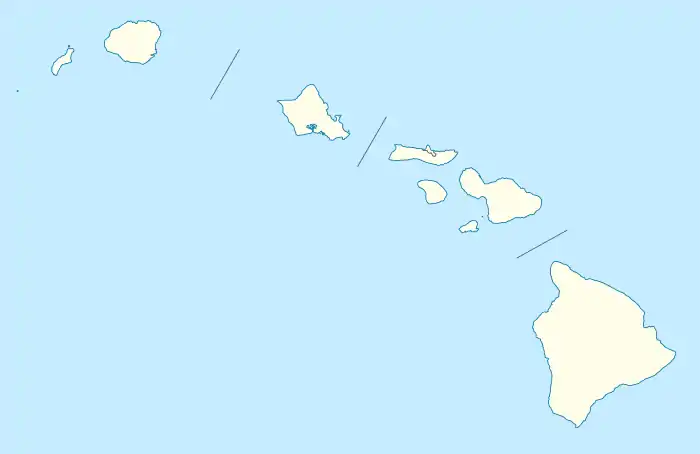Kukaniloko Birth Site
Kūkaniloko Birth Site, also known as the Kūkaniloko Birthstones State Monument, is one of the most important ancient cultural sites on the island of Oʻahu. It was first listed on the National Register of Historic Places in 1973 and its boundaries were increased in 1995,[1] after 5 acres (2.0 ha) of land which included the site became a state park in 1992.[2]
Kukaniloko Birth Site | |
 View from park entrance toward Kolekole Pass | |
 | |
| Nearest city | Wahiawa, Hawaii |
|---|---|
| Coordinates | 21°30′17″N 158°2′11″W |
| Area | 5 acres (2.0 hectares) |
| Built | prior to the 13th century |
| Architectural style | Ancient Hawaiian |
| NRHP reference No. | 73000674 and 94001640[1] |
| Added to NRHP | April 11, 1973 (original) and February 09, 1995 (increase) |
Geography
Kūkaniloko lies in the Wahiawā Plateau between Oʻahu's two mountain ranges: the Waiʻanaes to leeward, and the Koʻolaus to windward. It also lies at the intersection of two major paths of overland travel: the Waialua Trail between the North Shore and ʻEwa Beach, and the Kolekole Trail through the Waiʻanae Range.[2]
The site is not only the piko of the island, but its placement across from the Waiʻanae Range could have been used as a calendar. The sun could be observed at Kūkaniloko by using certain markers.
The present day location is near the intersection of Kamehameha Highway and Whitmore Avenue just north of Wahiawā, Hawaiʻi.[3]
History
Kūkaniloko, meaning "to anchor the cry from within," is the geographic piko (navel) of Oʻahu. Kūkaniloko was symbolically the most powerful birth site for the island's high chiefs,[4] among whom Kakuhihewa and Maʻilikākahi were perhaps most famous. At this site, women gave birth to aliʻi (royal) children, surrounded by ali'i witnesses.[3]
The Hoʻolonopahu Heiau associated with the site was later destroyed, as were many others in the area, to make room for sugarcane and pineapple fields in the rich soils where sweet potato and yam once grew in abundance. Chiefly families lived along the slopes of the Waiʻanaes overlooking the plateau and along the shores of Waialua to the north, and many key battles between rivals for control of Oʻahu were also fought on the central plains surrounding Kūkaniloko.[2]
The wide view of the skies from Kūkaniloko might also have made it a sort of Hawaiian Stonehenge.[5] In April 2000, a team from the University of Hawaiʻi Institute for Astronomy recorded designs and shapes on the stones that could have been used to track the movements of celestial objects for calendrical purposes.[6]
Gallery
 View from entrance stones to central stones
View from entrance stones to central stones Ki plants on raised earth platform
Ki plants on raised earth platform Shape of northern Waiʻanae Range
Shape of northern Waiʻanae Range Central stones and coconut palms
Central stones and coconut palms Plant offerings at central stones
Plant offerings at central stones Corrugated central stone
Corrugated central stone
References
- "National Register Information System". National Register of Historic Places. National Park Service. April 15, 2008.
- "Hawaii State Parks: Oahu: Kukaniloko Birthstones State Historic Site". official web site. Hawai'i Department of Land and Natural Resources. Retrieved 2010-02-05.
- Tarleton, Catherine (February 16, 2017). "Kukaniloko Birthstones: Where Hawaiian royalty was born". Hawaii Magazine.
- Simek, Kelly; Pili, Kamaka (April 30, 2018). "Aloha Authentic: Moku O Wahiawa". KHON News. Retrieved 27 May 2018.
- "Kukaniloko - a Hawaiian Stonehenge?". Retrieved 2009-12-28.
- "Kukaniloko Visit 4/12/00". University of Hawaii Institute for Astronomy. Retrieved 2009-12-28.
External links
- Where Royals Were Born: The 1,000-Year-Old Kukaniloko Birthing Site of Hawaii Ancient Origins, 17 Nov. 2016, retrieved 27 Apr. 2019.
- Barron, Kamira. Kukaniloko: A Living Legend
| Wikimedia Commons has media related to Kukaniloko Birth Site. |